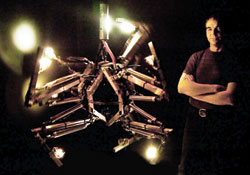Concordia Corner
Vorn adds robotic rock and roll to FOFA gallery

Artist Bill Vorn (aka academic Yves Bilodeau) poses with one of his robots currently on display at the FOFA gallery on the ground floor of the EV Building.
File Photo
The new FOFA gallery space on the ground floor of the EV building fronting Ste. Catherine St. has been transformed into an interactive robotic cocoon by Bill Vorn (Intermedia/Cyberarts).
“I try to turn the whole environment into a robot. My work needs a big space. Then I transform the physical space and make it disappear.”
The audience can enter the space and move around and between the robots suspended from the ceiling. Each movement provokes a reaction in movement, light and sound. The show is also visible from the street on a screen.
Vorn began his career interested in music and worked as a sound technician for a number of years. His desire to “bring sound and light together and to animate these two audio-visual components in space” led him to explore robotics.
Initially, he constructed robotic sound and light projectors to amplify the effect of musical compositions. Over time, his creations began to take on a life of their own. His robots became anthropomorphized, by accident as much as design.
“I added organic elements like arms and legs. That was not my intention, but I wanted an extension of the machines. They seemed more believable if they had potential as a living organism.” However, the metal cables and lasers don’t look terribly organic.
Red Light, like other shows, includes smoke. Vorn acknowledges some people consider the work to be rock and roll (he did found Rational Youth, an electronic music band, in the ’80s). But he uses the smoke and lights to provide a broader canvas for the beams of light that extend from the ‘limbs’ of his robots.
“The smoke provides more volume, and more movement, and accentuates the audio/visual component.”
The robots themselves interact with the viewer in entirely unpredictable ways. “I don’t want people to discover a trick to make them move this way or that way.” He programs the robots to react randomly. He likens the effect to approaching a big dog. It might wag its tail, or bite, or run away.
Vorn taught himself the mechanics, electronic and programming involved in his creation.
“But I’m the opposite of an engineer. They can work in a virtual world with formulae and simulations. I work in the real world, with real situations. What I do is more like sculpture.”
As much as possible, he uses simple components (like pneumatics) to produce complex effects. Simple components make it easier to move, reproduce or display the works.
“And if a single part breaks down, or crashes, or falls apart, there are so many other parts that it won’t affect the piece. People won’t even notice it.”